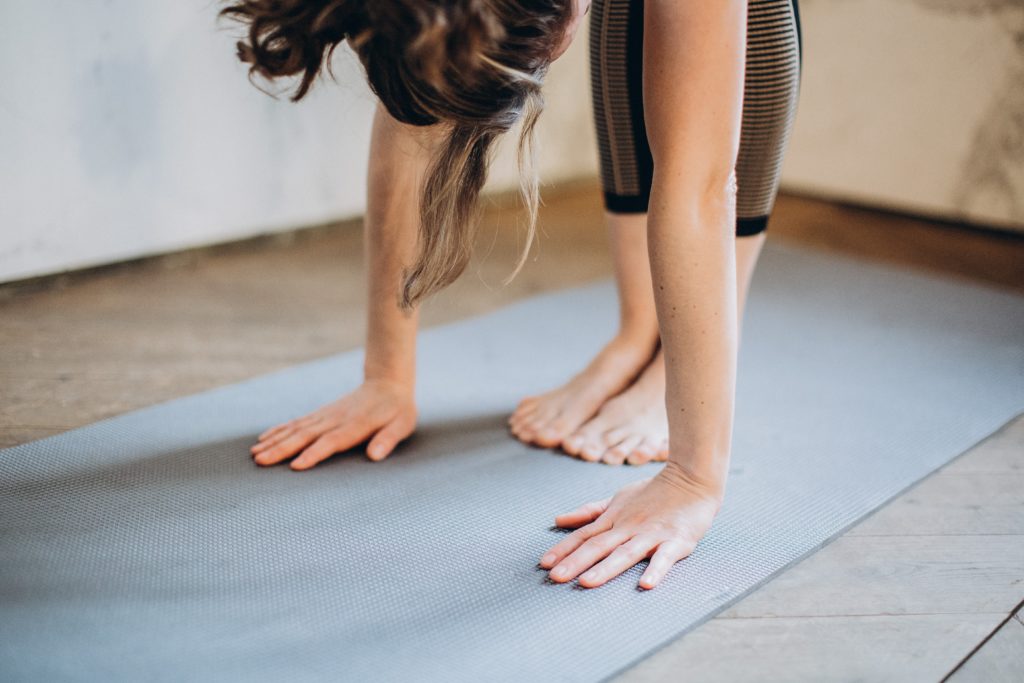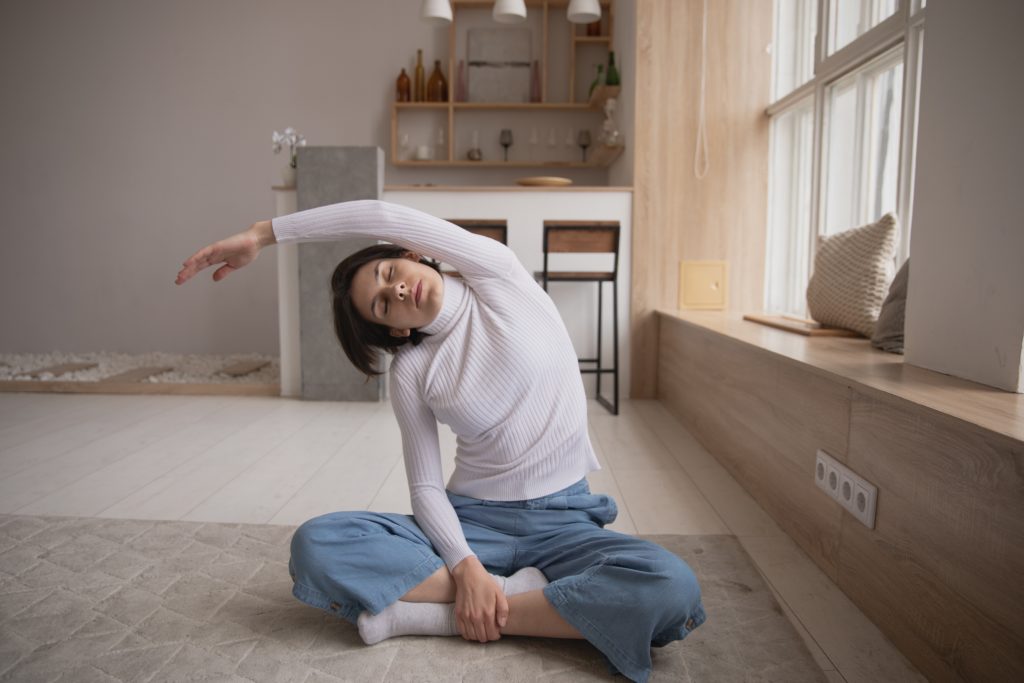
Mobility training – before or after the workout?
How much time do you spend sitting on average a day? Eight hours? Twelve? Most of us, you included, are sitting for the most part of the day: be it on the computer at work, at the university, in the restaurant, on the train or watching Netflix on the couch. You probably know that long hours of sitting is harmful to the body and can even make us sick. It is therefore all the more important to counteract this.
Movement and, above all, mobilization of our body is much too less in everyday life. So if you smirked at the question “Mobility – before or after the workout” because you have not yet integrated mobility into your daily routine, don’t worry – we spoke to Yvonne from SoulSport and will show you what mobility training actually means, why it is important and how you can easily integrate it into your everyday life.
What is mobility training?
Mobilization is a movement-based and integrated whole-body concept, whereby the muscle and joint interaction is trained. Mobility Training (or mobilization training) is a combination of stretching, coordination and strength training.

With Mobility Training, you can correct movement issues and performance deficits and with these targeted exercises you can also improve your mobility in general, and thus even improve your performance.
As mentioned, effective mobility training consists of various aspects of fitness which include stretching, coordination training, strength training and sliding surface exercises. This combination is applied at various levels and works on the whole body.
Mobility training is made up of these three aspects:
- Stretching exercises: The exercises help to improve the tolerance of your passive movement apparatus (tendons, ligaments, joint capsules, etc.) and make tendons, fascia and muscles more mobile.
- Sliding surface exercises or myofascial self-massage: An equally important part of the training that serves to improve the gliding ability and elasticity of the fascia.
- Muscle strengthening: You also work on muscle strengthening and train your body’s motor control.
Why is mobility training so important?
According to Yvonne, “We spend a lot of the day in a sitting position and unfortunately we often move much too less and that too unilaterally. We sit on the way to work, at school, in the office, at university, in a café, in a restaurant – movement and mobilization receive far too little attention here. Soon or later, you will have issues with your body, in your muscles and tissues. If you are not actively mobile, you will lose the flexibility that keeps you healthy. This will make your joints stiff and muscles and tendons will no longer be flexible. To prevent this, mobility training, with its holistic concept, acts as a preventive measure and also helps relieve existing complaints.”
What are the benefits of mobility training?

Regular mobility training has the following benefits:
- Improve and maintain your general and active mobility
- Increase the muscle strength
- Improve intermuscular coordination
- Helps the muscles to relax and improves the nutrient supply of the joints, muscles and tissues
- Expansion of your Range of Motion/your movement radius
- Prevention of calluses, injuries and malpositions
- Improvement of the gliding ability and elasticity of the fascia
- Support in other sports in terms of technical execution and effectiveness
Which exercises can a beginner do?
As a beginner, you should start with the morning and evening routines. You can start with light stretching exercises, joint rotation, shoulder and hip circles, arm swings and self-massage of the fascia tissue and gradually increase these exercises. If you perform the exercises daily, you can quickly feel a difference and the positive effects in the body. Over time, you can extend and expand the units.
How can I do mobility training at home?
No limits are set to your Mobility Training. You can start with simple mobility exercises in the morning immediately upon waking up. Start with rotations of the joints – from the fingers to the toes. Then you stretch the body lengthwise and stretch from vertebra to vertebra, stretch the neck, circle the shoulders and the hip and also light massage techniques are offered. A few minutes are sufficient.
To relax, you can use smash techniques in the evening. While sitting or lying on the floor, place a ball or fascia roller under the area you want to treat and gently roll back and forth. Breathe deeply and relax the muscles while breathing. Here, three minutes are sufficient to promote sliding surface mobilization.

The good thing about these small movements is that you can always include them in your daily routine – do hip circles while cooking, cutting vegetables, and stretch the vertebrae.
“If you regularly practice these small techniques, you can quickly feel a difference. Important is that the exercise sequence becomes a routine, just like brushing of teeth in the morning and evening”, says Yvonne from SoulSport.
How often should I practice mobility training?
In the beginning, it is sufficient to perform mobility exercises for about five to fifteen minutes every day. You can also integrate the mobilization exercises described above into your everyday life in order to remain mobile and take preventive measures. You need not perform the entire sequence at one go, a quick exercise while waiting for the bus or while working at the desk can work wonders in preventive health management. You can alternate between the sliding surface exercises and muscle dynamics activities. Integrate more intense units two to three times in your weekly schedule.

Should I do mobility training before or after my workout?
Whether you do mobility training before or after your workout, depends on various factors. Dynamic mobility exercises work best before your workout – so your body is properly warmed up. Mobility training according to your fitness regime can contribute to regeneration and allows you to go deeper into your practice and achieve significant mobilization in muscle dynamics.
“Both are equally important and it depends on what type of sport you want to play and what are your goals? Right warm-up has a significant influence on the training itself”, says Yvonne.
A warm-up is useful in many training types, but not suitable for all training types. For example, in Yin Yoga, a prior warm-up is not required. Here, you should avoid too much stretching until the end of your training, because this increases the risk of injuries. Dynamic mobility exercises should be done preferably before training. So your body is properly warmed-up and prepared for the upcoming training. Jumping, for example, is a suitable way to stimulate the nervous system, muscles, tendons and joints in an extremely dynamic manner.
After your workout, you can do a cool-down. It is the perfect time to work effectively on your mobility. Your body is warmed up and the joints and muscles are well-prepared for deep stretching. Static exercises are beneficial in the cool-down phase and prepare the body for rest and relaxation. In this case, sliding surface exercises work well too, as the tissues are warmed-up and can be exercised optimally.
What literature do you recommend on mobility?
- Calisthenics X Mobility: Stark – Beweglich – Schmerzfrei by Monique König
- Werde ein geschmeidiger Leopard: Die sportliche Leistung verbessern, Verletzungen vermeiden und Schmerzen lindern by Kelly Starrett
- Mobility: Das große Handbuch by Patrick Meinart and Johanna Bayer
- Sitzen ist das neue Rauchen: Das Trainingsprogramm, um lebensstilbedingten Haltungsschäden vorzubeugen und unsere natürliche Mobilität zurückzugewinnen by Kelly Starrett
In the last book, exercises are also described in detail and in small steps.
When can I take part in SoulSports mobility training?
You can take part in the mobility classes at SoulSports both online and on location. Be it Yoga for more mobility or lunch break stretching – here you can find several great classes for your mobility training. You will quickly realize the difference when you train your mobilization regularly.
Tuesday: 7:30 – 8 a.m. Yoga for Mobility
Wednesday: 12 – 12:30 p.m. Midday Mobility Break
Friday: 6:30 – 7 a.m. Morning Mobility



Comments